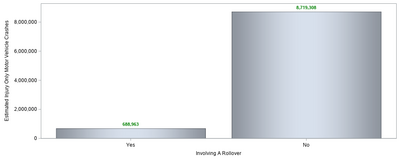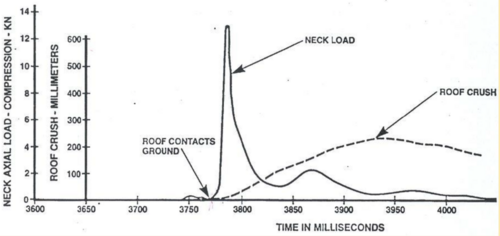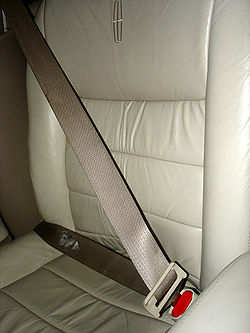Documentation:FIB book/Rollover
Overview
Introduction

Rollovers are a relatively rare but extremely severe vehicle crash scenario, comprising 3% of crashes but 33% of occupant deaths [1]. Moreover, occupants in rollover crashes had the largest probability of experiencing an AIS 3+ head injury compared to all other crash modes [2]. Rollover crashes are defined by Dobbertin et al. as “involv[ing] a vehicle that experiences at least two quarter turns (≥180 degrees) about its longitudinal axis” [3]. The kinematics in these crashes can be quite severe; in tests performed by Heller et al. with vehicles at approximately 70 kph, occupants experienced peak roll rates up to 700 degrees per second [4]. Rollover crashes are difficult to characterize as there are infinite variations in rollover scenarios and the immediate environment [5]. Typically, the first impact is with the road surface, and the following impacts involve either the road surface again or other vehicles, barriers, ditches, etc. These variations in crash scenarios make it difficult to characterize the injury biomechanics as well.
There are two injury scenarios for rollover crashes: those with belted and unbelted occupants. Unbelted occupants are frequently ejected from the vehicle; NHTSA found that 87 percent of ejected occupants in rollovers were unbelted [1]. The risk of both injury and fatality are greatly increased by ejection [6]. Because of the high rate of outright fatality from unbelted ejections and the dependency of injuries on the unique surrounding environment, this article will focus solely on injuries incurred from belted, non-ejection accidents.

Biomechanics
Several types of injuries result from rollover accidents. The most serious injury areas are related to the head and spine, which will be the focus of this article.

Head and Neck Injuries
A full 50 percent of the harm from rollover collisions is related to head and neck injuries [7]. The exact source and method of these injuries have historically been a subject of academic debate. The main point of contention is whether or not “roof crush” - deformation of the roof into the passenger compartment - is related to occupant injury. The most famous experiments which explored this topic are the landmark Malibu 1 and Malibu 2 experiments by Orlowski & Bundorf and Bahling et al., respectively.
The Malibu 1 experiment [8] sought to determine the effect of roof strength on injury with unrestrained passengers. In Malibu 1, eight dolly rollover tests were conducted using the 1983 Chevrolet Malibu. Four cars had their roofs in the stock configuration, and four received significant roof reinforcement via a roll cage. Each vehicle was instrumented and crewed with a pair of 50th percentile HIII ATDs. The study found that the reinforced roofs did not increase protection. The average neck load (3.3 kN with roll cage vs 3.7 kN without) and number of potentially injurious impacts (28 with roll cage vs 26 without) were nearly identical. The primary limitation of this experiment is that it was conducted on unbelted occupants,which was addressed by the Malibu 2 study.

Malibu 2 closely followed the experimental design of Malibu 1, with the main significant change being the usage of seatbelts on the HIII ATDs. Bahling et al. note that “no significant HIC numbers were observed for any of the eight tests” [9]. Instead, forces in the neck were used to compare the tests. Axial neck compression forces greater than 4000 N were recorded in all of the tests [9]. These measurements were well above the 2000 N Potentially Injurious Impact (PII) threshold, which makes cervical neck fractures probable [2]. Bahling et al. were able to definitively state that the ATD neck loads were induced by the torso moving towards the head while the head and roof were in contact with the ground, and peak neck loads occurred 10ms before any roof crush occurred, thus disproving the roof crush hypothesis.
However, the Malibu experiments have come under criticism in recent years. Several authors have levied criticisms at the Malibu I and II in recent years. In particular, Young et al. note that the PII threshold is regarded as an outdated standard and instead re-assess the Malibu II data using the NHTSA-approved Nij criterion[10]. They found that the average Nij for the reinforced vehicles in Malibu II was 0.60 compared with 1.28 for the stock vehicles. While both the Hybrid III ATDs and Nij criterion were developed for frontal impacts, Young et al. assert that the use of this criterion is still “biomechanically superior to the load criterion used by Bahling et al.” Additionally, Grzebieta et al. state that the Newtonian laws of physics can mathematically prove that the velocity of the roof intrusion is closely related to the neck loading of the occupant[11].
While the current body of literature provides excellent experimental data on rollover crashes, there are areas that would benefit from further investigation. First, as Young et al. note, the injury criterions used by both Bahling et al. and themselves are not well-suited for side impacts. There is currently no Nij equivalent for head and neck movement in the frontal plane. Second, the Malibu experiments do not reflect the state-of-the-art in both industry and research. Vehicle design and crash energy management techniques have advanced significantly in the past 30 years through the proliferation of computer-aided design and simulation. Finally, the Malibu experiments would benefit from advancements in ATD design; the BIOSID ATD is specifically designed for frontal plane impacts and might offer greater biofidelity.
Spine Injuries
Around 33% of all injuries occur to the spine during rollover collisions when occupants are wearing seatbelts [12]. The primary mechanisms for spine injuries during rollovers were torso diving and collision with roof intrusion[12]. Torso diving occurs when an occupant’s head collides with the vehicle’s roof, and their torso continues to move to the roof [11]. In Torso Diving, the rate of the occupant's torso movement is comparable to the rate at which the vehicle approaches the ground[11]. Another indicator/factor in injury is the amount of extension in the neck when the occupant makes contact with the roof, as the extension in the neck may change the neck curvature, which would then result in a different distribution of forces in the cervical spine[13]. There is a dispute in research whether there is a clear relation between vertical roof crush and the risk of injury to the spine.
Bambach et al. conducted a study where the spinal injury mechanisms of restrained occupants in real-world rollover collisions were compared with cadaver tests with similar loading [12]. The study population was obtained from Crashworthiness Data System (CDS) Query and focused on individuals who had sustained injuries in the face, head, shoulder and spine regions. The spinal injuries of occupants in rollover collisions were “localized to the C5 to C7 levels and predominantly consisted of body, lamina, pedicle, facet and transverse process fractures” [12]. However, the study did not find a clear increasing relationship between the vertical roof intrusion and the injury to the spine and predicted the injury risk to the spine could be primarily due to torso inertia, with the risk being added from roof intrusion.
Dobbertin et al. found a significant increase in spine injury risk “for each additional 10 cm of vertical roof crush”, contradicting previous research that determined little relation between crush and spine injury[3] . The dataset was acquired from the National Automotive Sampling System - Crashworthiness Data System (NASS-CDS) from 1997 to 2007. Subjects irrelevant to the study were filtered out as several criteria were considered. They focused only on: "single-vehicle rollover crashes, occupants seated in the front-left and front-right positions, autos, minivans, SUVs and pickups" [3]. Similar to the previous study, Funk et al. also found that the probability of cervical spine injury increased seven times for roof crush greater than 15 cm than for roof crush less than 3 cm [14]. Likewise, data from this study was also obtained from the NASS-CDS, this time looking at cases from 1995 to 2008. Crashes that involved occupants under 16 years of age or sustained injuries from non-rollover sections of the accidents were excluded[14].
A study done in 2007 mentions the effect restraints have on occupants in rollover collisions [15]. It found that restraints lead to the occupants being pre-flexion, leading to a “higher risk of cervical spine injury in the presence of an intruding roof structure when compared to unrestrained occupants” [15].
In a study published in 2019, Carolyn et al. used a Dynamic Rollover Test System(DRoTS) to perform rollover tests with six ATDs and four Post Mortem Human Surrogates(PMHS)[13]. The study used a buck with a rigid base and a deformable roof to match real-world scenarios and found that the one PMHS that did not sustain an injury had the largest roof crush[13]. Based on this result, the study suggested that a larger amount of roof crush did not relate to increased injury risk, even if the presence of roof crush may be an indicator of injury. The head position and anthropometry were identified as critical factors in injury, with the tallest PMHS being the only cadaver to sustain a fracture.[13]
The controversy of roof crush highlighted in research is very important, as it affects the prioritization of safety features and design in motor vehicles. Additionally, the criteria for safety would depend on roof crush if roof crush is confirmed as a primary mechanism for injury.
One limitation of the studies used is data limitation, as not all crashes are reported to the police. There was only a focus on impact with the roof structure rather than impact with other structures such as the seat back and steering column. The Bambach study focused mainly on AIS2 or 3 injuries, which comprised 91.2% of injuries, meaning that the results may translate poorly to severe spine injuries(AIS4+) [12]. Some other limitations include the definition of motor vehicle rollover, as there are differing opinions on the number of turns for a vehicle to be considered undergoing a rollover. Dobbertin et al. used the data from any vehicle that underwent a rotation of 90 degrees about the long axis, which results in a larger range of collisions considered as rollovers[3]. Additionally, Dobbertin et al. did not include the seated height, and the recording of roof crushes as a cause of injury was subject to the crash investigator [3]. The 2019 study using PMHS and ATDS had a very small sample size, and the surrogates do not have a musculature response[13]. Both studies using the NASS-CDS dataset had very similar time frames, indicating that their data could be duplicates of each other, resulting in similar conclusions.
Protective Design Measures
Occupant Safety Measures

The best way automobile occupants can protect themselves from injury during a rollover crash is to wear a seatbelt, particularly a 3-point seatbelt. Seatbelts reduce fatality risk from rollover by 91 times [14].

Car Manufacturers Protective Design Measures
Bambach et al. suggested that designs with the reduction of roof intrusion should also have restraints to prevent loads from inertial loading and also suggested that dynamic rollover occupant protocols should be implemented with accurate measurement methods [12].
The US government introduced roof-strength standards (FMVSS) to ensure that vehicle manufacturers were testing their roof’s structural integrity. This is important as multiple studies and tests have shown that vehicles with more roof deformation tended to have more injured occupants [8]. For example, for vehicles that weigh up to 6,000 pounds, their roofs must be designed to withstand 3 times the vehicle’s weight[16] .
Another design measure that has been adopted to protect occupants from rollovers is rollover-activated (through an Angular Rate Sensor, ARS) side curtain airbags, which are used as an extra safety measure in addition to seatbelts [17]. Results show that these airbags are 23% effective in reducing fatalities for belted occupants [17]. Although this percentage seems low, it is important to note that rollovers are very unpredictable, and effects depend on various factors.
In the future, research can be done into the types and sizes of seatbelts and how they impact the likelihood of head or spinal injury. Since all the papers have only looked at the drivers of rollover crashes, it would be beneficial to include additional data on the injuries suffered by passengers seated in different locations in the vehicle in informing protective design measures. Additionally, developing a neuromuscular control system for a cadaver could be helpful, especially for rollovers, as these types of accidents occur for a relatively longer duration. This greater time frame has allowed occupants in the vehicle to react to their situation and brace for impact [13]. A neuromuscular control system can account for this factor in testing. The results from this neuromuscular control system could also inform the development of an ATD that is more suitable for rollovers (i.e. can respond similarly to the cadaver). Furthermore, the vast automotive and technological advances brought through autonomous driving technology could be valuable to research occupant response and injuries sustained when performing sensor-based collision prevention maneuvers and automated braking.
Practice Problems
References
- ↑ 1.0 1.1 “Rollover data special study final report - NHTSA,” untitled, Jan-2011. [Online]. Available: https://www.nhtsa.gov/sites/nhtsa.gov/files/811435.pdf. [Accessed: 10-Nov-2022]
- ↑ 2.0 2.1 D. C. Viano and C. S. Parenteau, "Analysis of Head Impacts Causing Neck Compression Injury," Traffic Injury Prevention, vol. 9, (2), pp. 144-152, 2008.
- ↑ 3.0 3.1 3.2 3.3 3.4 K. M. Dobbertin et al, "The relationship between vehicle roof crush and head, neck and spine injury in rollover crashes," Accident Analysis and Prevention, vol. 58, pp. 46-52, 2013.
- ↑ M. F. Heller et al, "Occupant Kinematics and Injury Mechanisms During Rollover in a High Strength-to-Weight Ratio Vehicle," SAE International Journal of Passenger Cars. Mechanical Systems, vol. 3, (1), pp. 450-466, 2010.
- ↑ M. Mackay, "Mechanisms of injury and biomechanics : vehicle design and crash performance," World Journal of Surgery, vol. 16, (3), pp. 420-427, 1992.
- ↑ J. R. Funk et al, "Factors affecting ejection risk in rollover crashes," Annals of Advances in Automotive Medicine, vol. 56, pp. 203-211, 2012.
- ↑ H. El-Hennawy et al, "Epidemiology, causes and prevention of car rollover crashes with ejection," Annals of Medical and Health Sciences Research, vol. 4, (4), pp. 495-502, 2014.
- ↑ 8.0 8.1 K. F. Orlowski, R. T. Bundorf, and E. A. Moffatt, “Rollover Crash Tests—The Influence of Roof Strength on Injury Mechanics,” SAE Transactions, vol. 94, pp. 1073–1095, 1985, Accessed: Nov. 12, 2022. [Online]. Available: https://www.jstor.org/stable/44724106
- ↑ 9.0 9.1 G. S. Bahling et al, "The influence of increased roof strength on belted and unbelted dummies in rollover and drop tests," The Journal of Trauma, vol. 38, (4), pp. 557-563, 1995.
- ↑ D. Young et al, "Diving versus roof intrusion: a review of rollover injury causation," International Journal of Crashworthiness, vol. 12, (6), pp. 609-628, 2007.
- ↑ 11.0 11.1 11.2 R.H. Grzebieta, D. Young, M. Bambach, & McIntosh, “Rollover crashes: Diving versus roof crush,” 20th International Technical Conference on the Enhanced Safety of Vehicles, Lyon, France, June 2007
- ↑ 12.0 12.1 12.2 12.3 12.4 12.5 M. R. Bambach, R. H. Grzebieta, A. S. McIntosh, and G. A. Mattos, “Cervical and thoracic spine injury from interactions with vehicle roofs in pure rollover crashes,” Accident Analysis & Prevention, vol. 50, pp. 34–43, Jan. 2013, doi: 10.1016/j.aap.2012.10.006.
- ↑ 13.0 13.1 13.2 13.3 13.4 13.5 C. W. Roberts, J. Toczyski, and J. R. Kerrigan, “Cervical spine injury in rollover crashes: Anthropometry, excursion, roof deformation, and ATD prediction,” Clinical Biomechanics, vol. 64, pp. 42–48, Apr. 2019, doi: 10.1016/j.clinbiomech.2018.04.004.
- ↑ 14.0 14.1 14.2 J. R. Funk, J. M. Cormier, and S. J. Manoogian, “Comparison of risk factors for cervical spine, head, serious, and fatal injury in rollover crashes,” Accident Analysis & Prevention, vol. 45, pp. 67–74, Mar. 2012, doi: 10.1016/j.aap.2011.11.009.
- ↑ 15.0 15.1 M. W. Bidez, J. E. Cochran, D. King, and D. S. Burke, “Occupant Dynamics in Rollover Crashes: Influence of Roof Deformation and Seat Belt Performance on Probable Spinal Column Injury,” Annals of Biomedical Engineering, vol. 35, no. 11, pp. 1973–1988, Jul. 2007, doi: 10.1007/s10439-007-9355-1.
- ↑ “Department of Transportation National Highway Traffic Safety ... - NHTSA.” [Online]. Available: https://www.nhtsa.gov/sites/nhtsa.gov/files/fmvss/Roof_Crush_Final_Rule.pdf. [Accessed: 03-Dec-2022].
- ↑ 17.0 17.1 J. Padmanaban and M. Fitzgerald, “Effectiveness of Rollover‐Activated Side Curtain Airbags in Reducing Fatalities in Rollovers,” trid.trb.org, 2012. https://trid.trb.org/view/1253233 (accessed Nov. 12, 2022).